In 2016, my new discovery of a photo of Hanashiro Chōmo was featured on the website of the Okinawa Traditional Karate Liaison Bureau. Then, in 2018 I translated and published the Genealogy of Hanashiro.
Today I add an overview of Hanshiro’s life, and the attempt to reconstruct the fragmentary survivals of his “Karate Kumite” (1905), the first work considered to have used the modern characters for Karate.
Hanashiro was born in the village of Shuri on July 26, 1869 as the 3rd son of father Chōkō 長康 (1834 to not earlier than 1876) and mother Magosei 真呉勢, in turn the daughter of Sakumoto Chikudun Pēchin Kashō 佐久本親雲上嘉政. Hanashiro’s childhood name was Masanrā 眞三良, and his Chinese-style name was Min Zōsei 明増盛.
While his modern-era name is Hanashiro, the correct old-style designation of his family would be “House Kameya of the Min-Clan.” It was a keimochi (“lineage holder”) family from Shuri which originated in Atetsū Pēchin Chōson (1556 – 1609) (Cf. Genealogy of the Min-Clan, House of Kameya, in: Okinawa no Rekishi Jōhō: 679 – 693, as well as in Higa 2005). Hanashiro Chōmo was in the 11th generation of this lineage, but – as the 3rd son – not heir to it.
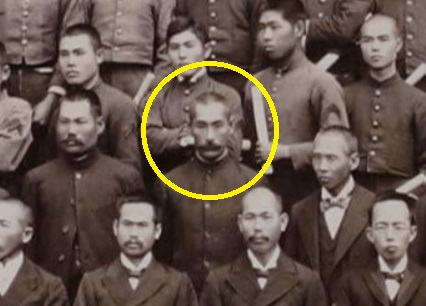
Synopsis
In accordance with the new Meiji educational system, formal physical education had been introduced in the Shuri Middle School in 1887 and later became the basis for military-drill schedules (Kerr 1958: 413-14). Although Okinawa had been the only Japanese prefecture exempted from the otherwise nation-wide Conscription Ordinance (chōheirei) of 1872 (Smits 1999: 149), in December 1890 ten young Okinawans volunteered for training as noncommissioned officers at the Rikugun Kyōdōdan military academy of the Imperial Japanese Army (Kerr 1958: 418. OKKJ 2008: 544). Among those were Hanashiro Chōmo, Kudeken Kenyū (1869–1940) and Yabu Kentsū (1866–1937). Hanashiro was 21 years old at the time.
Just like Yabu, Hanashiro participated in both the campaigns of the 1st Sino-Japanese War (1894–95) and the Japanese-Russian War (1904–05), whereby he was promoted from sergeant (gunsō 軍曹) to first lieutenant (chū’ī 中尉). Awaiting the approaching enactment of general conscription in Okinawa (1898) and in the social situation of draft evasion taking place one after another, Hanashiro counted among the volunteer soldiers which of course also made him expedient for propaganda, just like Kentsū Yabu (OKKJ 2008: 494).
After one and a half decades in the military, Hanashiro retired from active service and in 1905 entered his position as a sports teacher at the 1st Prefectural Middle School of Okinawa. At that time the school had about six hundred pupils and more than twenty teachers, and physical education and military drill being part of the curriculum (Leavenworth 1905: 56). Itosu Ankō taught karate at that middle school. Hanashiro initially served as his assistant and later took over instruction until around 1912, when he retired from the 1st Prefectural Middle School. Afterwards he opened a dōjō in Naha Asato, where he devoted himself to the dissemination of karate (OKKJ 2008: 494).
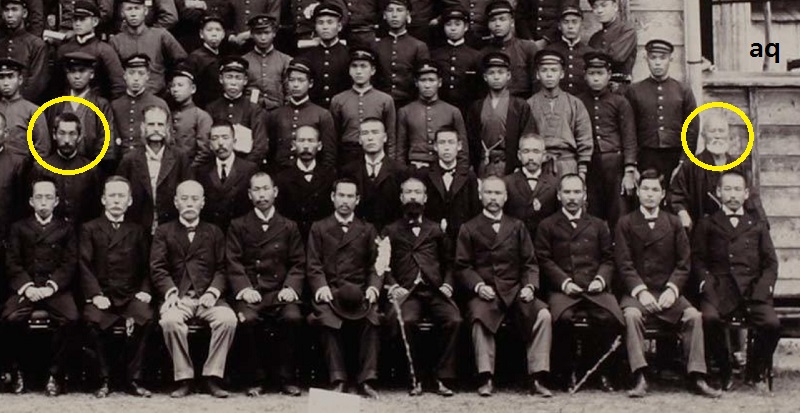
In September 1919 he was elected village headman of Mawashi, one of the three old districts of Shuri (together with Nishihara and Haebaru, and collectively referred to as Shuri Mihira). This took place according to the special system of communal organization of the Meiji Constitution, which provided the right to local self-government. In June of the following year, with the abolition of the special old system of communal organization, Hanashiro resigned. Later, in 1924 he was elected a member of the village assembly. While again being engaged in the village system, he has been instrumental in teaching and spreading karate (Okinawa Dai Hyakka-jiten, 1982).
In 1926 he participated in the Okinawa Karate Club 沖縄唐手倶楽部, together with Motobu Chōyū, Mabuni Kenwa (1889-1952), and Chibana Chōshin (1885-1969). In 1934 he taught Karate at Azato.
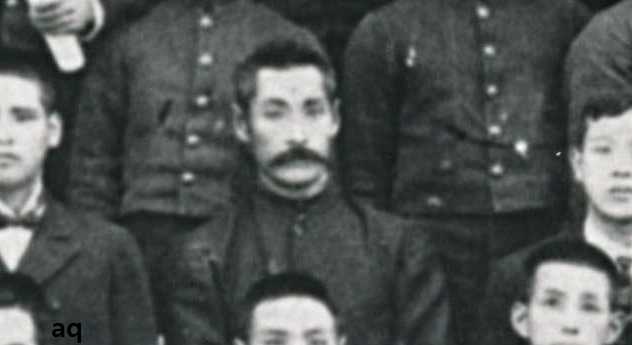
On October 25, 1936 Nakasone Genwa gathered the experts of that time and conducted the “Karate Symposium” held under the auspices of the Ryūkyū Shinpō newspaper. BTW, this symposium was the motivation for the decision of the Okinawa Prefecture Assembly of 29 March 2005, to declare October 25 the “Day of Karate (Karate no hi 空手の日).” Among the prominent budōka participating in this symposium were Hanashiro Chōmo, Kyan Chōtoku, Motobu Chōki, Miyagi Chōjun, Kyoda Jūhatsu, and Gusukuma Shinpan.
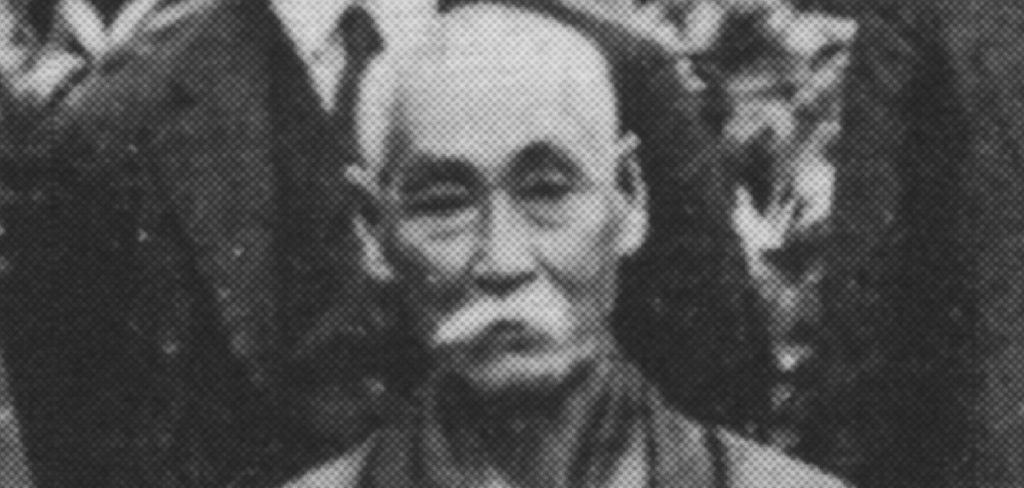
One of the topics of the 1936 symposium was the question of the formal notation as Karate 唐手, or as Karate 空手. At that time, Hanashiro mentioned that he had used the notation Karate 空手 already decades ago. Two years afterwards, in 1938, Nakasone Genwa published “Karate-dō Taikan.” Featured in it is the cover and the sole remaining text page of Hanashiro Chōmo’s historical “Karate Kumite 空手組手” of 1905. Here, Hanashiro has used the modern notation of Karate for the first time in literature.
Hanashiro Chōmo died in 1945 in Nakaoji in Haneji Village, aged 76 years. The Kata called Jion ジオン (慈恩) is said to have been his specialty. Photographs of Hanashiro performing Jion can be found in the above-mentioned “Karate-dō Taikan.”
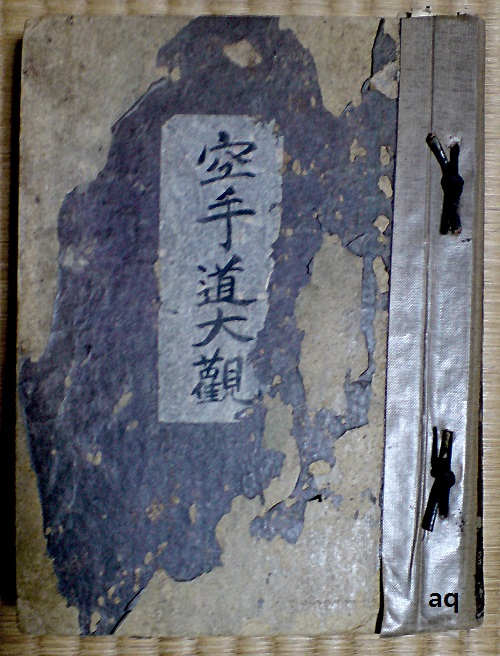
Cover of Karatedo Taikan, original edition from the possession of Nagamine Shoshin. Photo by Andreas Quast, 2008 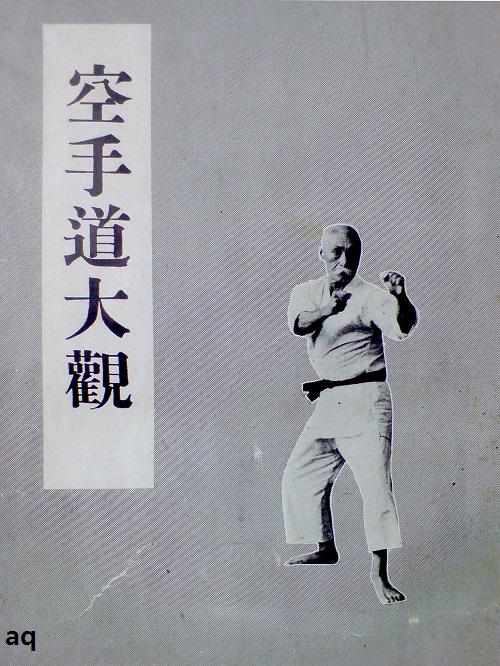
Hanashiro Chomo. Photo by Andreas Quast, 2008 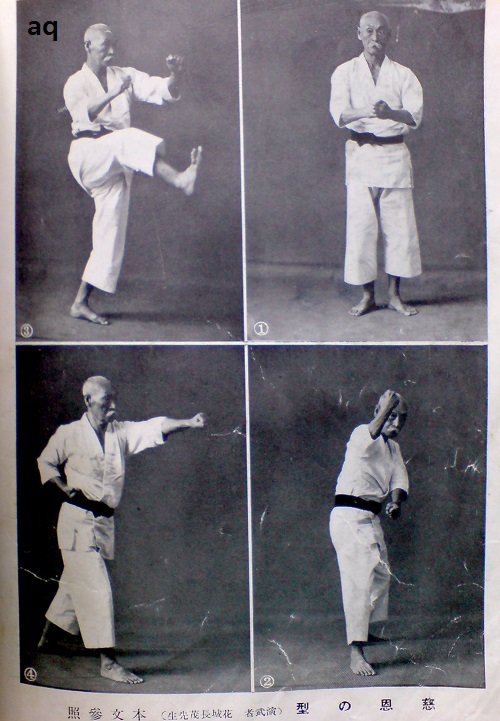
Hanashiro performing Jion. Photo by Andreas Quast, 2008 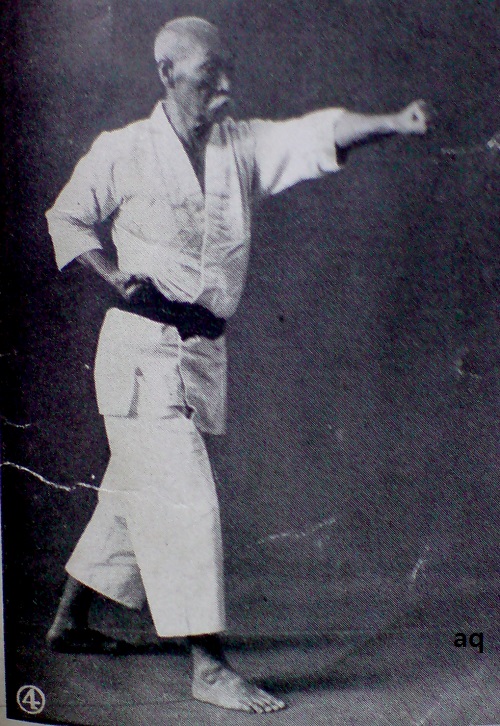
Hanashiro performing Jion. Photo by Andreas Quast, 2008 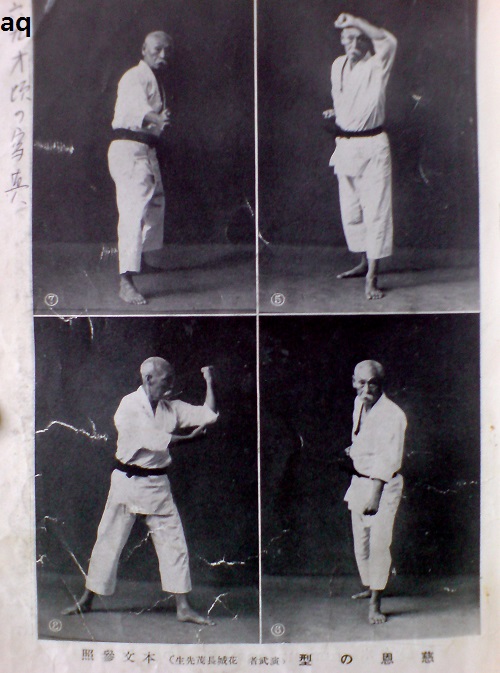
Hanashiro performing Jion. Photo by Andreas Quast, 2008 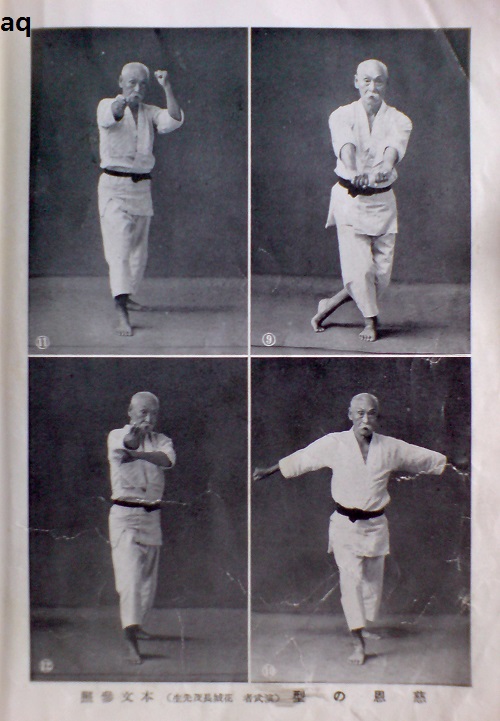
Hanashiro performing Jion. Photo by Andreas Quast, 2008
Hanashiro is an important person in the history of modern Karate. Besides Kuwae Ryōsei, he is the only other person documented to have received a handwriting by Matsumura Sōkon (Wittwer 2007: 7). Hanashiro’s edition was dated “the 7th month of the Year of the Ox.” Only one photograph of the last page of this document has been handed down (in Karate-dō Taikan 1938: 64). The photo’s caption says
“Matsumura’s ink handwriting (from the archives of Hanashiro Chōmo Sensei).”
The photo shows an ink written page, sealed and signed by “Matsumura Chikudun Pēchin.” The content and scope of the text is unknown (Wittwer 2007: 7). Because of this it is impossible to conclude whether Hanashiro received it from Matsumura’s bequest or whether the handwriting was specifically prepared by Matsumura for Hanashiro. If it was the latter, according to Hanashiro’s lifedates, which are uncontroversial, two specific years come into consideration. First, the Year of the Earth Ox 1889/01-1890/01, when Hanashiro was around twenty years of age. And second, the Year of the Metal Ox 1901/02-1902/02, when he was around thirty-two years of age. Although the first of these is more close to popular belief, the later date cannot be ruled out either. In any case, both dates point to an era ten to twenty years after the end of the Ryūkyū Kingdom and the establishment of Okinawa Prefecture.
Besides, it was also Hanashiro who handed down “Itosu’s 10 Precepts of Karate”:
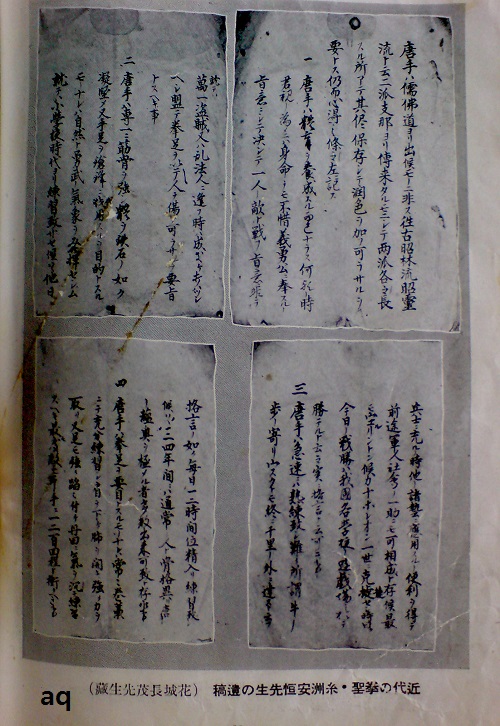
Karate Kumite, 1905
In February 1905, the Ryūkyū Shinpō published an article about the introduction of Karate in the 1st Prefectural Middle School in Shuri.
After in 1904 the Shuri Middle School staff intended to take up karate, they immediately commenced preparations. At present the results are proper. It is sufficiently understood that the teachers simultaneously serve in two roles–i.e. as regular school teachers, and as karate teachers. However, one inadequacy is that the teachers do not have a methodical explanation of the subject. Therefore, after having accumulated a reasonable skill in karate, we hope that they create a program that largely matches our country’s current society and that they research and develop karate technically, mentally, and as a physical education. […] We are in the process of getting the ball rolling in jūjutsu, wherein the West still has to start working. The fact that karate originates in the prefectural middle school is a great delight.
Chūgakkō Shokuin no Karate–Kyōikukai (The Karate of the Middle School Staff Members. Education World). In: Ryūkyū Shinpō, February 05, 1905. Translated by A. Quast.
The above article shows that the staff of the 1st Prefectural Middle School prepared the implementation of karate into the regular curriculum since 1904. It is also apparent that this was considered the first and original approach, which means that a new framework was being devised. As shown in the reference to jūjutsu, karate’s new face was that of an Okinawan form of the conception of jūjutsu/jūdō. It should be noted that the West became strongly interested in jūjutsu following Japan’s military successes in the Russo-Japanese War 1904–05, hence the reference in the article. Karate was thus designed to become a regional bujutsu-style physical education of Okinawa Prefecture.
The article also calls for staff members to create a programm for karate. A few months later, in August 1905, the physical education instructor Hanashiro Chōmo of that school created the basic textbook called “Karate Kumite” (Kadekaru 2012: 178).
Only the title page and one text page of Hanashiro’s “Karate Kumite” survived. They were included in the “Karate-dō Taikan,” published by Nakasone Genwa in 1938 in Tōkyō. From the above mentioned history and from the title we can see that this document was drafted for the purpose of teaching karate kumite at the Middle School in Shuri. The original handwriting was deciphered by Mr. Kadekaru Tooru and published by Kinjō Hiroshi in 2011.
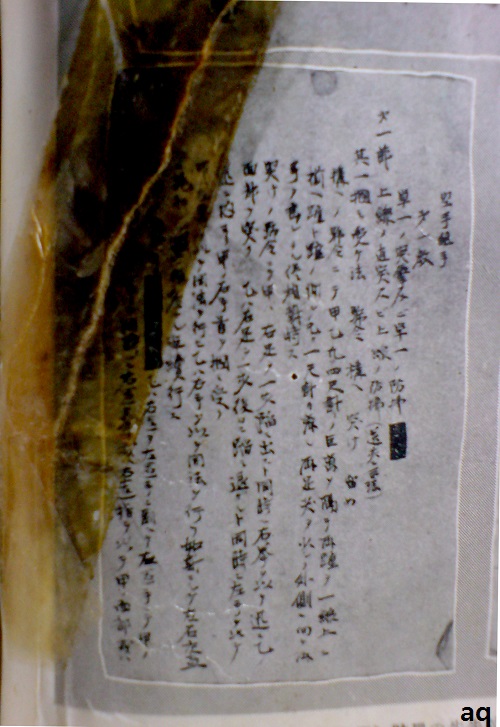
Karate Kumite, the surviving text 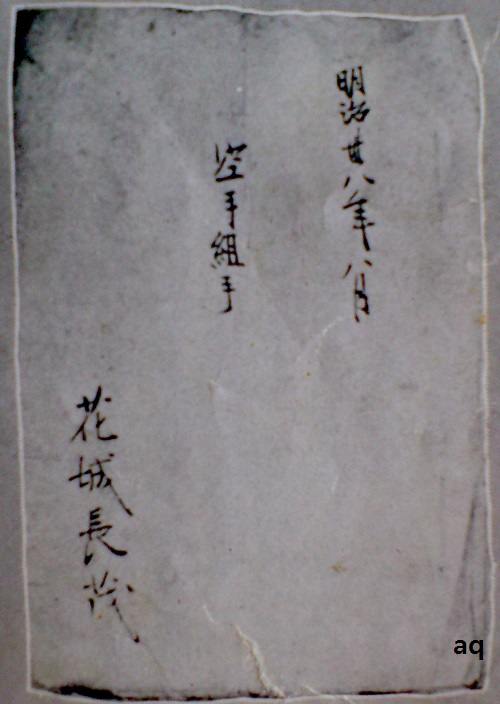
Karate Kumite, the surviving cover
“Karate Kumite” – English Interpretation
Karate Kumite
First teaching: A single thrust (tsuki) and a single defensive sweep.
Paragraph 1: upper-level direct thrust (choku-zuki) and upper-level defensive sweep (the selected soldiers perform the techiques three times)
This is a about the seizing method of defense (tsukami-uke-hō) .
Words of command are 1) assume posture (kamae) , 2) thrust (tsuke), and 3) stop (yame/dome) .
Upon the command “assume posture” (kamae), both parties A and B stand separated at a distance of approximately 1.20 meters, with both heels aligned on one line, and the heels about 30 centimeters apart, and with both foot tips slightly pointing to the outside, and both hands kept apart and raised appropriately in relation to each other.
Upon the command “thrust” (tsuke), A steps forward one step with his right leg and with his right fist simultaneously swiftly thrusts to B’s face.
B evades by taking one step backwards with the right leg, and with his left hand from the inside simultaneously swiftly seizes A’s right wrist (tsukami-uku).
A performs the opening-method with his left fist, then B perfoms the opening-method with his right hand. This is alternately continued with the other hand, until the command “stop” (yame).
Upon the command “stop” (yame), B attaches his right hand to his left hand, and with his left seizes A’s right fist (tsukami-uke) and simultaneously with his right fist, or alternatively with the fingers of his right hand, [thrusts to] A’s face, or otherwise [thrusts to a different part of A’s body, like solarplexus, or suprasternal notch]
From: Nakasone Genwa (pub.): Karate-dō Taikan. Tōkyō Tosho Kabushiki-gaisha, May 5th, 1938.
Clearly, what is called “Kumite” here is not what is currently called free kumite (jiyu-kumite 自由組手). Rather, it is yakusoku (promised) kumite 約束組手, where two persons face each other and repeatedly attempt prearranged offensive and defensive techniques.
Because there is only one page of text, and the last sentence is cut at the end of the page, I added a probable ending in square brackets [].
What Sort of Document is “Karate Kumite”?
There are interesting expressions found in Hanashiro’s “Karate Kumite” (1905), a book considered to have been written for karate instruction of school children at the 1st Prefectural Middle School in Shuri. One expression is bōfutsu/fusebarai 防拂à防払 or “defensive sweep.” During Hanashiro’s era, this phrase was typically found in manuals for military drill (heishiki taisō), of which there are numerous examples. These military drill manuals included didactically prepared descriptions of the individual equipment that was used, the commandos, formations, the methods of moving forward and backward, individual and partner exercises, etc. The structure and general fashion of such manuals match with that of Hanashiro’s “Karate Kumite.” Actually, the two opponents of the karate kumite where referred to by Hanashiro as the “selected soldiers” (選兵).
Examples of such manuals for military drill are:
Kōryoku Sei: Guntōjutsu jikyō Zen. Tsuke – Jōba Guntō-jutsu (The Complete Instructions in the Art of the Military Sword/Sidearm/Bayonet. Appendix: Horse Riding Military Sword/Sidearm/Bayonet) . Gunju Shōkai, Tōkyō 1910 (Meiji 43) . 紅緑生 著:軍刀術示教 全。『附乗馬軍刀術』。軍需商会、明治43年 (1910) 。
Gunju Shōkai Hensan-bu: Tenpan-rei Kenkyū no Shiori. Dai San Shū. (Guide to the Study of Standard Orders. Collection 3) . Gunju Shōkai, (1907-08) . 軍需商会編纂部 著:典範令研究ノ栞。第3集。軍需商会、明治40-41年 (1907-08) 。
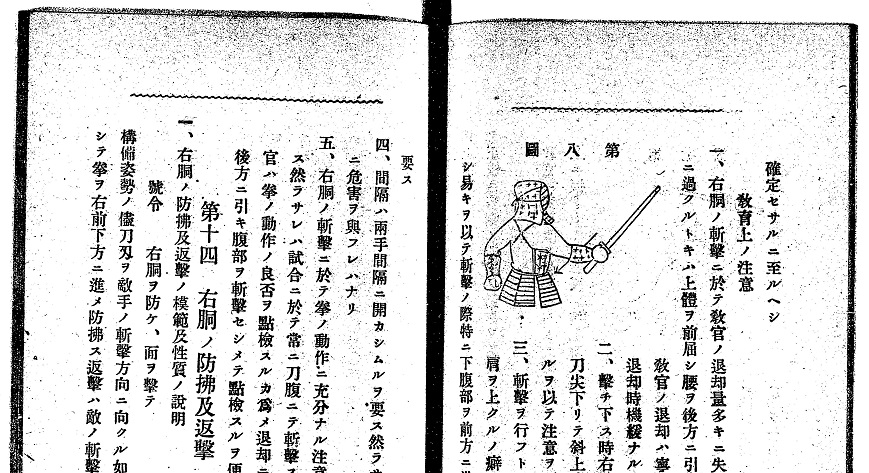
In this connection it is interesting to note that the characters for Karate 空手 might have had a different meaning than we think. That is, exactly the same Kanji as used for Karate appeared in the antique book Kyūyō for the year 1524 in the report on Kyōahagon, and again for 1709 in the report on Gima from Hija Village. There it was used the term Kūshu 空手, which are the same characters as for Karate, but simply mean unarmed, with empty hands, carrying no weapons, and have otherwise no relations to modern Karate whatsoever.
Moreover, in 1921 Buyōken Kensai published a book called “Karate Goshin Hijutsu – Sokuza Katsuyō” (The Secret Art of Karate Self-protection – Instant Application). Here, too, “Karate 空手” simpy meant “empty handed.” Otherwise this book would have been the first monograph about “Karate.”
If “Karate Kumite” was inspired by and had the same aims and contents as the other manuals for military drill at that time, Hanashiro might have simply used the term Karate in the title to refer to “unarmed” combat, as opposed to the use of weapons, and as opposed to a century-old indigenous combat methodology of Ryūkyūan provenance.
© 2019 – 2023, Andreas Quast. All rights reserved.
